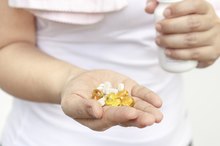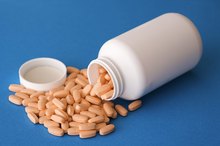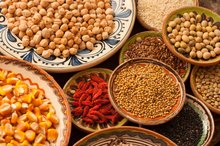What in Vitamins Makes My Urine Turn Yellow?
Multivitamins, B-complex vitamins and even heavily vitamin-fortified cereals will often cause your urine to turn a bright, seemingly unnatural shade of yellow. Although this might alarm you the first time it happens, it is an entirely normal response when you have ingested a high dose of riboflavin, also called vitamin B-2.
Function of Riboflavin in the Body
Together with other B vitamins, riboflavin helps the body release energy from carbohydrates, contributes to the metabolism of fat and is critical in the creation of red blood cells. In addition to these functions, there is some evidence to support the idea that riboflavin acts as an antioxidant, which may help prevent some forms of cardiovascular disease and cancer. At higher doses, vitamin B-2 has been used in some people to fight migraine headaches and possibly cataracts; however, more research is necessary to confirm these observations.
Recommended Dietary Allowance for Riboflavin
Can You Get Vitamin B12 Anemia If You Had Your Gallbladder Removed?
Learn More
When looking at the nutrition label of most multivitamins or B-complex supplements, you might think that a person needs high amounts of riboflavin and other B vitamins. But, rather than the 25, 50 or 75 milligrams often found in these commercial products, a typical adult woman only needs 0.9 milligram per day, and a typical adult male only needs 1.1 milligrams per day. These small amounts are easily met with a well-balanced diet, and deficiencies are often only seen in people with malabsorption problems, which can occur in celiac disease, alcoholism and occasionally in the elderly. That said, people who are very physically active, such as laborers and athletes, may have an increased need for riboflavin, reports the Linus Pauling Institute.
- When looking at the nutrition label of most multivitamins or B-complex supplements, you might think that a person needs high amounts of riboflavin and other B vitamins.
- That said, people who are very physically active, such as laborers and athletes, may have an increased need for riboflavin, reports the Linus Pauling Institute.
Foods and Beverages That Supply Riboflavin
Riboflavin is present in a wide variety of foods. Dairy products including milk are some of the best sources of B-2. If you choose not to consume dairy or you cannot due to dairy allergy or intolerance, additional healthy sources of the vitamin include legumes, nuts, lean meats, green leafy vegetables, eggs and nuts. In the United States, many grain products, including flours, breads and cereals, are also fortified with riboflavin during the manufacturing process, which means that the vitamin is added to the food in higher doses than would normally be present.
- Riboflavin is present in a wide variety of foods.
- In the United States, many grain products, including flours, breads and cereals, are also fortified with riboflavin during the manufacturing process, which means that the vitamin is added to the food in higher doses than would normally be present.
Other Effects of Excess Riboflavin
B12 Levels in Skim Milk
Learn More
Historically, scientists believed that riboflavin toxicity was rare because the excess is excreted via the urinary tract system -- thus, the bright yellow color of the urine. But some recent studies have suggested possible damage to the eyes, nerves and connective tissue if B-2 is taken in large doses. In addition, consult your physician if you experience urinary pain when taking supplements containing mega-doses of riboflavin, since this may indicate that your bladder lining is damaged -- a condition called interstitial cystitis.
Related Articles
References
- University of Maryland Medical Center: Riboflavin
- University of Chicago Celiac Disease Center: FAQs
- MedlinePlus: Riboflavin
- National Institutes of Health. Riboflavin — Health Professional Fact Sheet. Updated March 6, 2020.
- Mcnulty H, Dowey LRC, Strain JJ, et al. Riboflavin Lowers Homocysteine in Individuals Homozygous for the MTHFR677C→T Polymorphism. Circulation. 2005;113(1):74-80. doi:10.1161/CIRCULATIONAHA.105.580332
- Riboflavin. In: Institute of Medicine (US) Standing Committee on the Scientific Evaluation of Dietary Reference Intakes and its Panel on Folate, Other B Vitamins, and Choline. Dietary Reference Intakes for Thiamin, Riboflavin, Niacin, Vitamin B6, Folate, Vitamin B12, Pantothenic Acid, Biotin, and Choline. Washington, DC: National Academies Press (US); 1998.
- Condo M, Posar A, Arbizzani A, Parmeggiani A. Riboflavin Prophylaxis in Pediatric and Adolescent Migraine. J Headache Pain. 2009;10(5):361-365. doi:10.1007/s10194-009-0142
- Powers HJ. Riboflavin (vitamin B-2) and health. Amer J Clin Nutr. 2003;77(6):1352-1360. doi:10.1093/ajcn/77.6.1352
- Weikel KA, Garber C, Baburins A, Taylor A. Nutritional modulation of cataract. Nutr Rev. 2014;72(1):30-47. doi:10.1111/nure.12077
- Kennedy DO. B Vitamins and the Brain: Mechanisms, Dose and Efficacy--A Review. Nutrients. 2016;8(2):68. doi:10.3390/nu8020068
Resources
Writer Bio
Julie Beyer's writing has been featured in Today's Dietitian, Disease Management, ICA Update, ICN Optimist and professional newsletters since 1999. She has written four books about interstitial cystitis and self-publishing. A registered dietitian, Beyer teaches for University of Phoenix and holds a Master's in health communications from Michigan State University.








